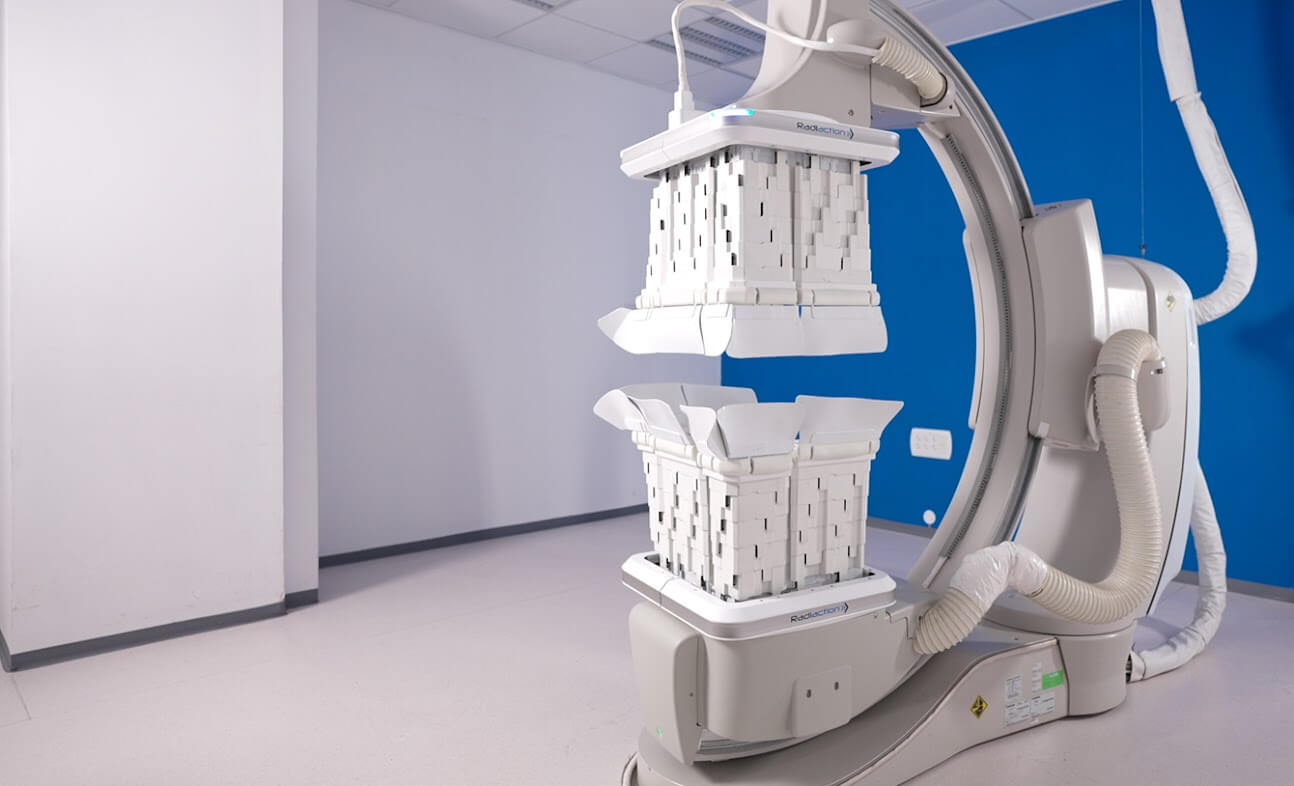Protecting Staff From Scatter Radiation
The Radiaction system is the first comprehensive solution to block radiation proactively at the source, protecting everyone in the interventional room from head to toe. Radiaction is clinically supported with extensive lab testing and real-world, peer-reviewed, published literature validating its performance in live clinical settings. The system’s fast, effortless, dynamic operation maintains workflow efficiency and allows complete access to patients during the cath lab procedures.
First Evaluation in the Clinical Environment
The first real-world clinical use of the Radiaction system was evaluated in PCI catheterization and Electrophysiology (EP) laboratories. PCI means radiation reduction rate shown at 91.2% throughout the entire room, and in EP procedures (Including CIED), 93.3% throughout the entire room.

A Novel Robotic Radiation Shielding Device for Interventional Cardiology Procedures
Avishag Laish-Farkash1, MD, PhD; Emanuel Harari1, MD; Ariel Finkelstein2, MD; Guy Sheinman1, MD; Michael Rahkovich1, MD; Yonatan Kogan1, MD; Eli Israel Lev1, MD
1. Cardiology Department, Assuta Ashdod University Medical Center, Ben-Gurion University of the Negev, Ashdod, Israel; 2. Cardiology Department, Tel Aviv Sourasky Medical Center, Tel Aviv University, Tel Aviv, Israel
Introduction
Fluoroscopy-guided interventional procedures are the leading source of occupational ionising radiation exposure for medical personnel1. The prevailing radiation protection measures for interventional personnel include: reduced radiation imaging systems, personal protective clothing, ceiling-mounted shields and table-skirts. However, interventional personnel continue to be exposed to high cumulative doses of X-ray radiation, which may increase the risk for malignancies1, early development of cataracts2, and orthopaedic problems due to the heavy weight of lead aprons3.
Newer dedicated solutions, such as suspended radiation protection systems4 and a remote-controlled robotic system5,6, provide protection only to the main operator, limit free movement (zero-gravity) and require...
An Opportunity to Reduce Lead Apron Thickness and Weight by up to 75%
During fluoroscopy-guided medical procedures, the medical team must wear lead aprons as protective clothing and act as a radiation shield. The gold standard weight required today is 0.5Pb and is often required to be worn for hours daily. The long-term wearing of lead aprons is known as a common cause of occupational hazards, such as cervical and lumbar spinal injuries. Lighter lead aprons are available, which weigh less and thus can be easier to wear during long periods, but also provide less protection from scattered radiation. The need for a better solution has gained much attention in recent years.
Laboratory Study
Decreasing wearable lead apron thickness and weight by up to 75% while providing comparable protection from radiation exposure enabled by novel radiation shielding device.
Method
Radiation protection was tested by measuring the scatter radiation in the catheterization lab using three different setups: (1) 0.5Pb lead aprons with no shield system in use, (2) 0.25Pb lead aprons with the shield system in use, and (3) 0.125Pb lead aprons with the shield system in use.

Results
The reduction in radiation for the three different setups was:
- 97% reduction for 0.5Pb lead aprons with no shield system
- 98% 0.25Pb lead aprons with the shield system in use
- 96% 0.125Pb lead aprons with the shield system in use
These results suggest that when using half the weight of lead aprons (0.25Pb), along with the shield system, the reduction in radiation is superior to that of the standard 0.5Pb lead apron used today. Furthermore, wearing 0.125Pb aprons with the shield system in full use provides the same level of protection as the 0.5Pb lead apron.

A Novel Robotic Radiation Shielding Device for Electrophysiologic Procedures: A Prospective Study
Avishag Laish-Farkash, MD, PhD1, Emanuel Harari, MD1, Michael Rahkovich, MD, Yonatan Kogan, MD, Gergana Marincheva, MD, Guy Scheinman, MD, Eyal Ben-Assa, MD, and Eli I. Lev, MD Ashdod, Israel
Introduction
Fluoroscopy-guided procedures are the leading source of occupational ionizing radiation exposure for electrophysiologic (EP) personnel.1 High cumulative doses of X-ray radiation might increase the risk for malignancies,1 early development of cataracts,2 and orthopedic problems due to the heavy weight of lead aprons.3 Reducing high radiation exposure during medical procedures is the principal task of many professional societies and advisory groups.4,5
User Feedback Proved the Feasibility and Ease of Use for All Types of EP Procedures
A robotic Radiaction Shield System (RSS) was developed to provide full-body protection to all medical personnel during fluoroscopy-guided procedures by encapsulating the imaging beam and blocking scatter radiation.
Objective
We aimed to evaluate its efficacy in real-world electrophysiologic (EP) laboratories during ablations and cardiovascular implantable electronic devices (CIED) procedures.
Method
A prospective controlled study comparing consecutive real-life EP procedures with and without the Radiaction Shield System using highly sensitive sensors in different locations.
Results
Thirty-five ablations and 19 CIED procedures were done without the shield system installed, and 31 ablations and 24 CIED procedures (17 with usage levels ≥70%) were done with the shield system. Using Radiaction did not increase procedure time and radiation time.
- Overall there was a 95% average usage level for ablations and 88% for CIEDs
- For all procedures with ≥70% usage level and all sensors, the radiation with the shield system was significantly lower than radiation without
- For ablations, there was an 87% reduction in radiation with the shield system
- For CIEDs, there was an 83% reduction in radiation with the shield system

Conclusion
For both CIED and ablation procedures, the radiation with the Radiaction Shield System was significantly lower than without. Higher usage level brings higher reduction rates. Thus, the shield system may have an important role in the full-body protection of all medical personnel from scatter radiation during EP and CIED procedures.
Upcoming Studies
Radiaction Medical will release new studies, education, and research regularly, so please check back here for the latest information on our system and its application.
Know the Risks to the Healthcare Team
In the interventional suite, daily radiation exposure puts physicians and staff at significant risk for radiation-based complications such as cataracts, cognitive degradation, tumors, cancers, thyroid disease, cardiovascular diseases, and fetal exposure. On top of this, the standard heavy lead aprons physicians and staff currently use can lead to an array of orthopedic problems while only offering partial protection.

University of California San Diego Health System
“I think that radiation is a concern when you look at women choosing cardiology and EP as a sub-specialty…there are a number of barriers going into the field, but radiation comes up as a concern every time we talk about this. It’s a very real phenomenon, and women think about it before choosing a specialty.”
Dr. Ulrika Birgersdotter-Green, Cardiac Electrophysiologist and Cardiologist
Education in Innovative Radiation Protection Technology
Is radiation in your lab as low as reasonably achievable (ALARA)? Have confidence that Radiaction will help you minimize your exposure to scatter radiation and stay below your dose limits.
There are three ALARA safety measures to focus on:
*Center for Disease Control and Prevention (2022).
*Jaquith, K. (2018). The ALARA Principle: 3 Safety Measures To Follow.
*College of Physicians and Surgeons and the Alberta College of Medical Diagnostic and Therapeutic Technologists.


